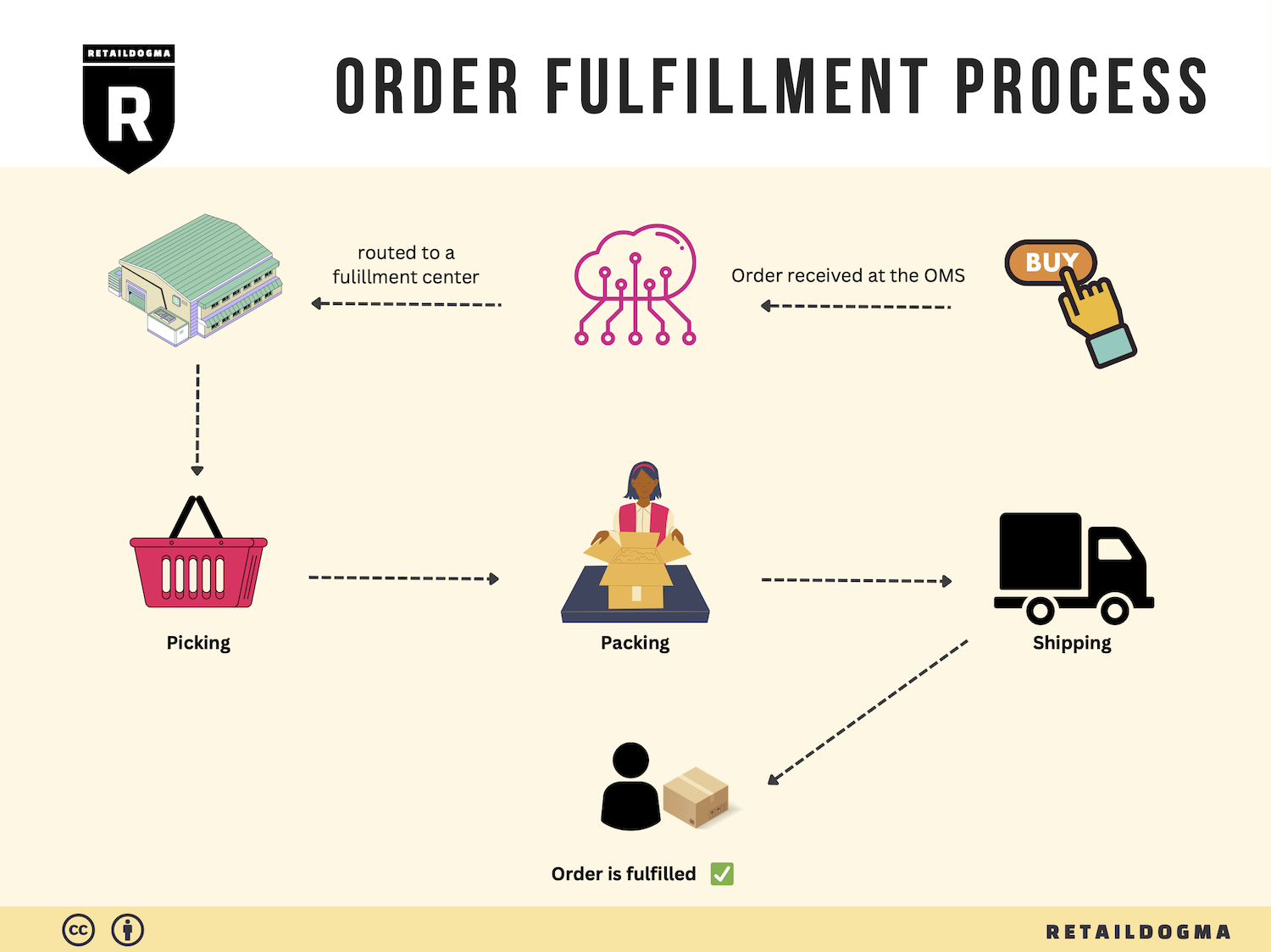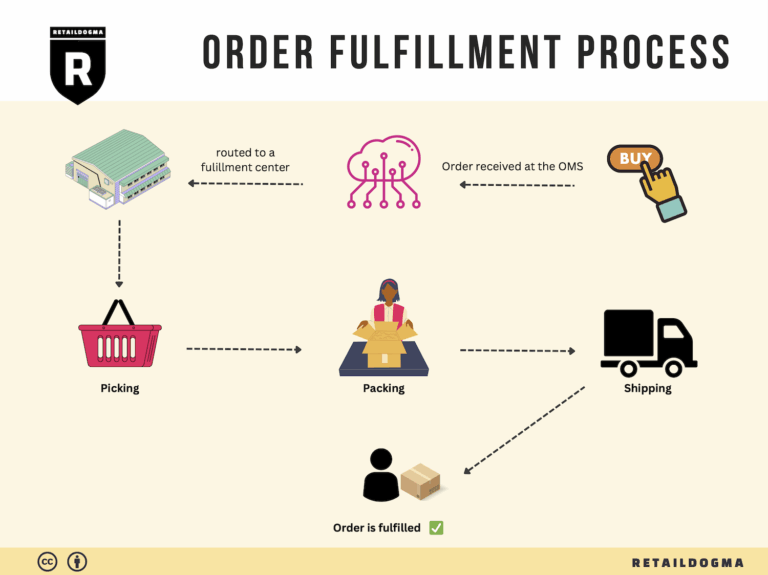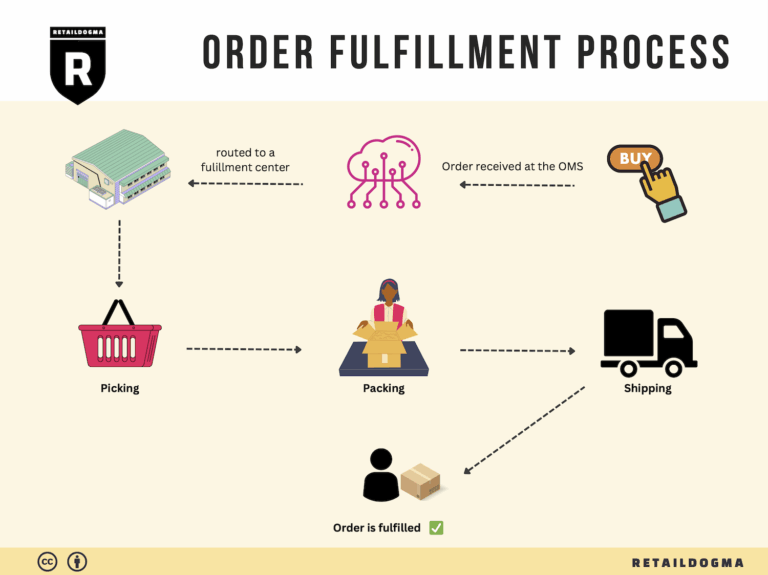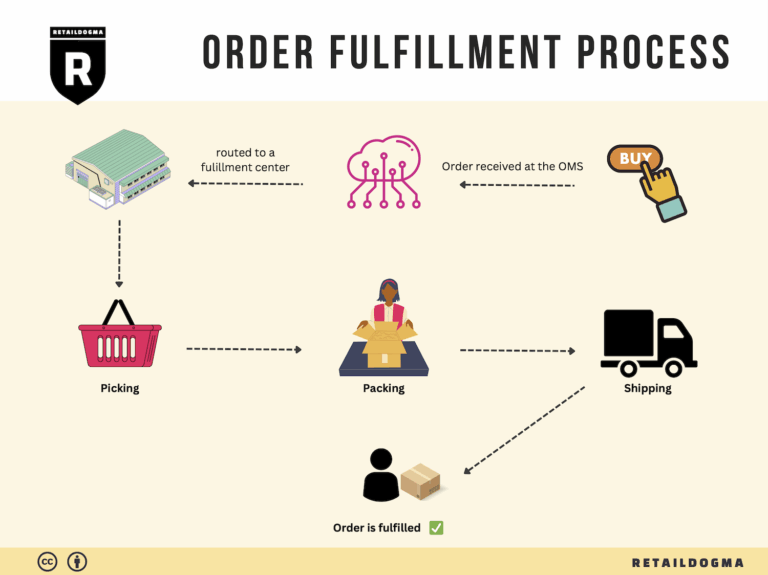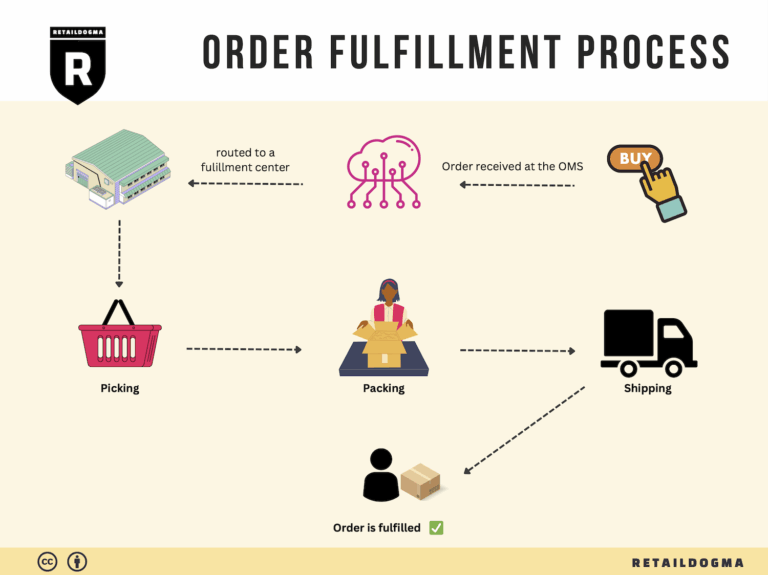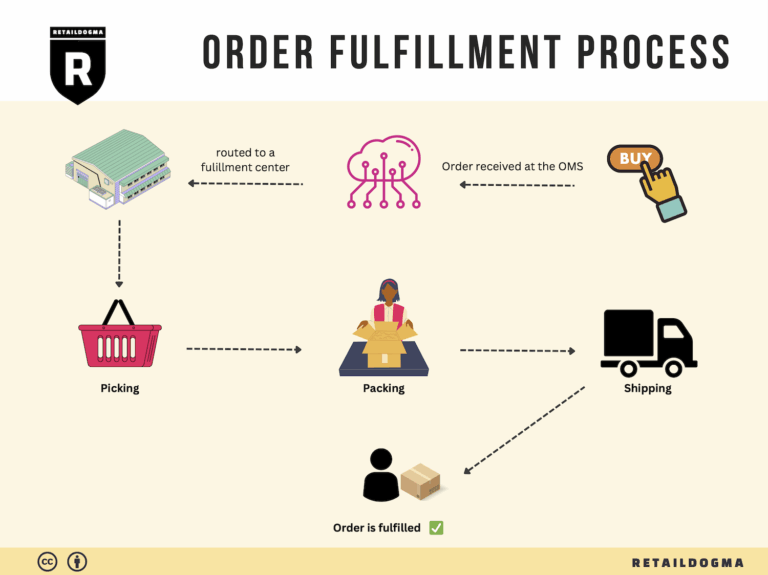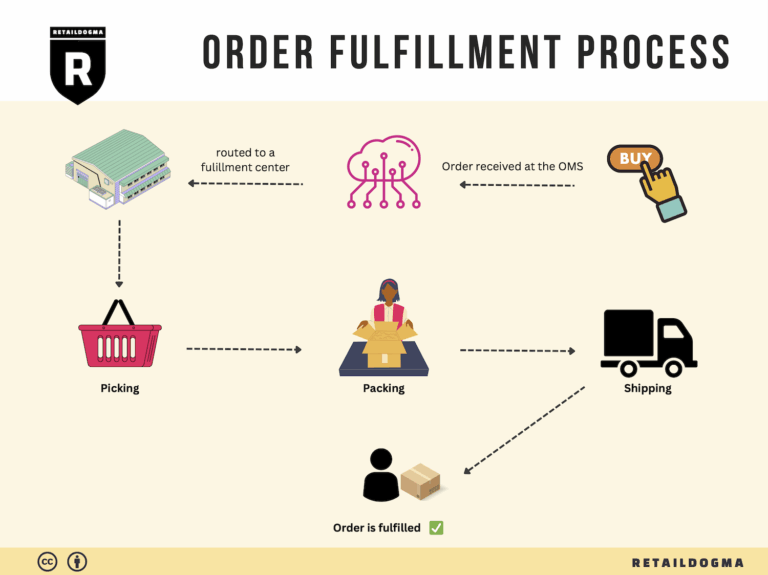How Order Fulfillment Works: A Step-by-Step Guide for Businesses
What is E-commerce Fulfillment? An Introduction for Growing Businesses
Understanding the Challenges of Order Fulfillment
As a growing online business, the excitement of increasing sales can quickly turn into a daunting challenge when faced with the complexities of packing and shipping orders. Many entrepreneurs find themselves overwhelmed by the sheer volume of orders, struggling to keep up with inventory management, packaging, and delivery schedules. This often leads to longer processing times, dissatisfied customers, and ultimately, lost sales.
Defining E-commerce Fulfillment
At its core, e-commerce fulfillment is the process of getting a product from your inventory into the hands of your customers. This includes everything from receiving inventory, storing products, and processing orders to packing, shipping, and handling returns. Efficient fulfillment is crucial for maintaining customer satisfaction and scaling your operations effectively.
What This Guide Will Cover
This comprehensive guide aims to demystify e-commerce fulfillment for growing businesses. We will explore various fulfillment models, including:
- Third-Party Logistics (3PL): Partnering with a logistics provider to handle warehousing and shipping.
- Fulfillment by Amazon (FBA): Utilizing Amazon’s extensive network for storage and distribution.
In addition to these models, we’ll delve into the core services involved in fulfillment, such as inventory management, order processing, and return handling. Understanding these services will help you identify what your business needs to optimize its logistics.
Choosing the right fulfillment partner is a critical decision that can impact your business’s efficiency and customer satisfaction. This guide will provide practical tips for evaluating potential partners, including assessing their technology, service offerings, and pricing structures.
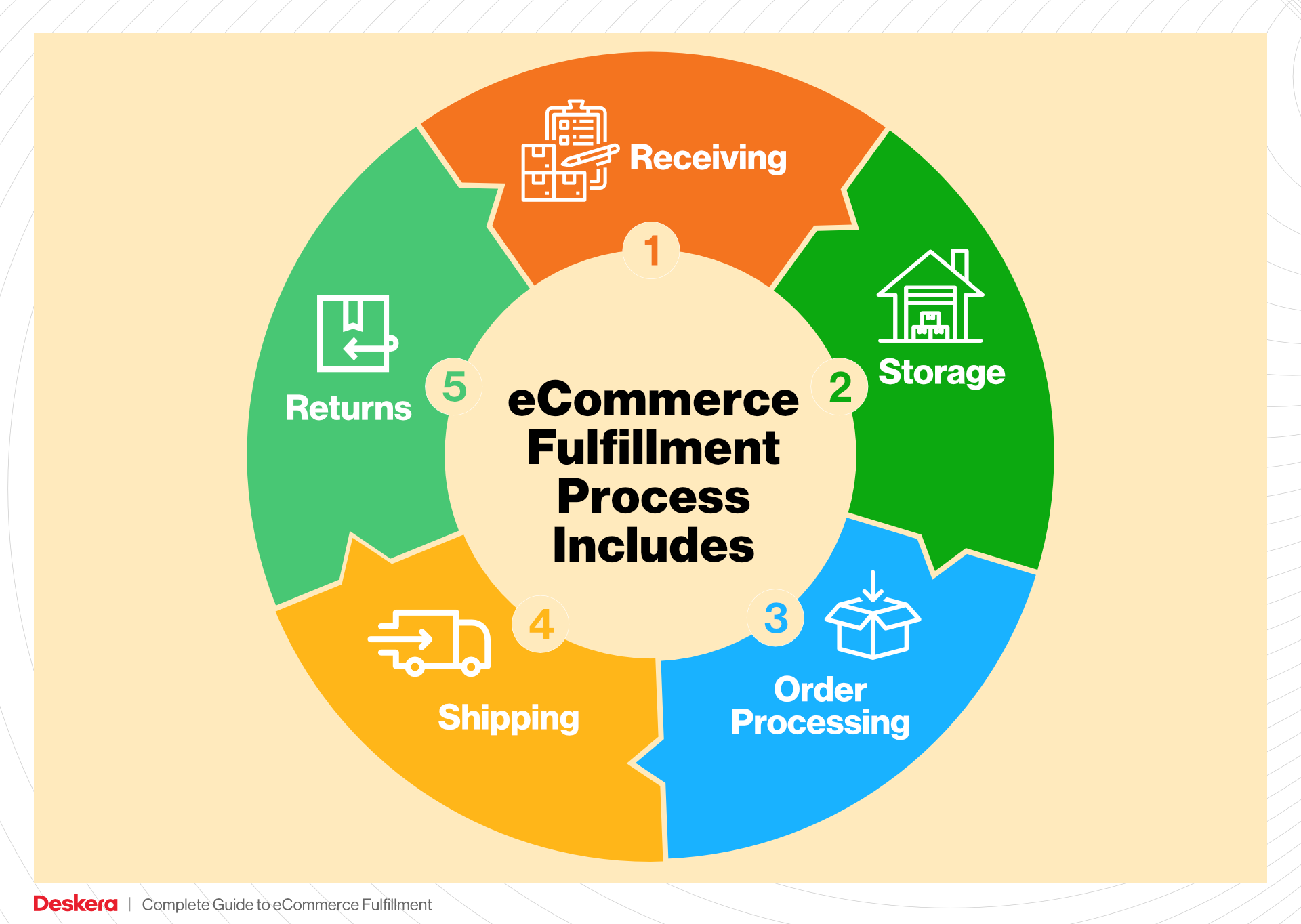
Pricing Models Explained
Pricing can be a significant concern for many e-commerce businesses. We’ll break down the various pricing models used by fulfillment centers, including pay-per-order, storage fees, and additional service charges. Understanding these costs will enable you to make informed decisions that align with your budget and operational goals.
Empowering Your Logistics Decisions
Ultimately, the goal of this guide is to empower you with the knowledge needed to make smart decisions about your logistics. By understanding the fundamentals of e-commerce fulfillment, you can streamline your operations, enhance customer satisfaction, and position your business for sustainable growth. Whether you’re just starting or looking to scale, this guide will serve as a valuable resource in navigating the complexities of e-commerce fulfillment.
What You’ll Learn In This Guide
- What is E-commerce Fulfillment? An Introduction for Growing Businesses
- The Order Fulfillment Process: From ‘Buy’ Button to Customer’s Door
- Comparing Fulfillment Models: In-House vs. 3PL vs. Dropshipping
- A Deep Dive into Amazon FBA: Pros, Cons, and Who It’s For
- Core Services Offered by Fulfillment Centers
- How to Choose a Fulfillment Partner: A 6-Point Checklist
- Understanding Fulfillment Pricing: A Breakdown of Common Fees
- Frequently Asked Questions (FAQs) about Fulfillment
- Conclusion: Is Outsourcing Fulfillment the Right Move for Your Business?
- Important Disclaimer
The Order Fulfillment Process: From ‘Buy’ Button to Customer’s Door
1. Receiving Inventory
The first step in the order fulfillment process is receiving inventory. This involves the intake of products from suppliers into the fulfillment center. Upon arrival, shipments are checked against purchase orders to ensure accuracy in quantity and quality. Each item is assigned a Stock Keeping Unit (SKU), a unique identifier that helps track inventory efficiently.
Importance: Proper receiving is crucial because it sets the foundation for inventory accuracy and stock management. Any discrepancies at this stage can lead to issues down the line, such as stockouts or overstocking, which can affect customer satisfaction and operational efficiency.
Key Term: SKU (Stock Keeping Unit) – A unique identifier for each distinct product and service that can be purchased.
2. Warehouse Storage
Once inventory is received and verified, it is stored in the fulfillment center. This step involves organizing the warehouse efficiently to optimize space and streamline future picking processes. Products may be stored in designated areas based on their SKU, size, or sales velocity, often using a Warehouse Management System (WMS) to track their location.
Importance: Effective warehouse storage is critical for maximizing efficiency. A well-organized warehouse reduces the time taken to locate items, which directly impacts order fulfillment speed. It also minimizes the risk of damage or loss, ensuring that products remain in sellable condition.
Key Term: Warehouse Management System (WMS) – A software application that helps manage warehouse operations, including inventory tracking, storage management, and order processing.
3. Order Picking
Order picking is the process of retrieving products from the warehouse to fulfill customer orders. This step usually starts once an order is placed, triggering the creation of a pick list that guides warehouse staff to the exact locations of the items needed. Depending on the volume and type of orders, picking can be done manually or through automated systems.
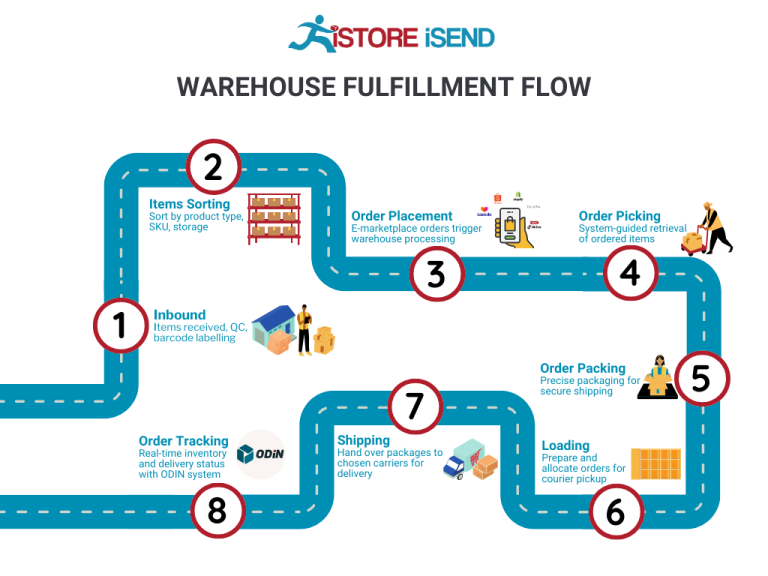
Importance: The efficiency of the picking process directly affects the overall order fulfillment timeline. Faster picking leads to quicker order processing and shipping, which enhances customer satisfaction. Moreover, accuracy in picking is vital; errors can lead to returns and additional shipping costs.
Key Term: Pick List – A document or digital tool that details the items to be picked for an order, including their locations in the warehouse.
4. Order Packing
After items are picked, they are packed for shipment. This involves carefully placing products into packaging materials to protect them during transit. Packing not only includes ensuring that the correct items are included but also involves labeling packages with relevant shipping information and barcodes for tracking.
Importance: Proper packing is essential for minimizing damage during shipping and ensuring that orders arrive in perfect condition. Additionally, well-packed orders can help optimize shipping costs by using space efficiently and potentially reducing dimensional weight charges.
Key Term: Dimensional Weight – A pricing technique used by shipping carriers that calculates shipping costs based on the package dimensions as well as weight, encouraging efficient packing.
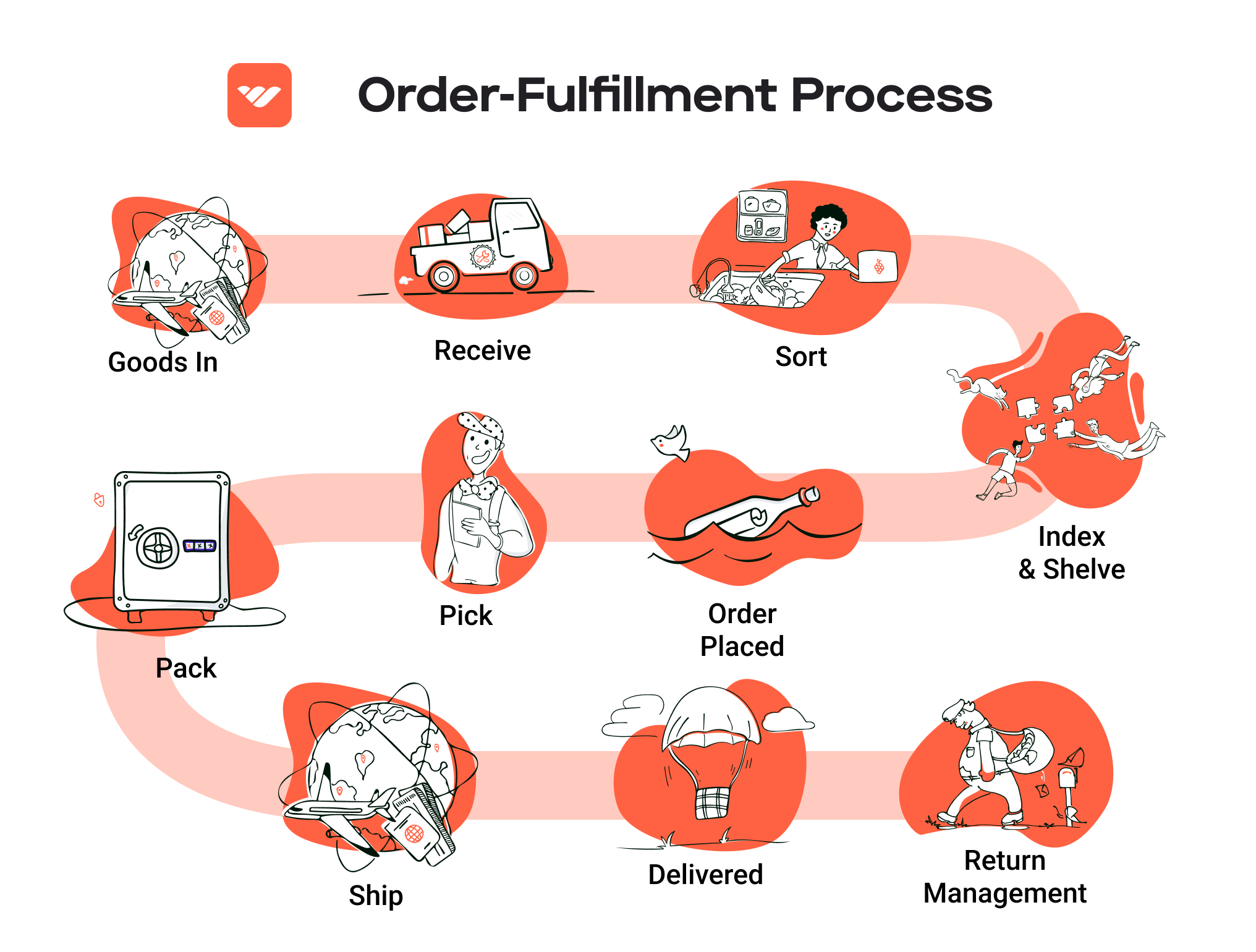
5. Shipping & Delivery
The final step in the order fulfillment process is shipping and delivery. Once orders are packed, they are handed over to shipping carriers for delivery to customers. This stage involves selecting the appropriate shipping method based on cost, speed, and customer preferences. Tracking information is generated and communicated to customers, allowing them to monitor their orders.
Importance: Timely and accurate delivery is a key factor in customer satisfaction. A reliable shipping process not only enhances the customer experience but also encourages repeat business. Additionally, having a clear understanding of shipping options and costs helps businesses manage their budgets effectively.
Key Term: Tracking Information – A unique code provided by the shipping carrier that allows customers to monitor the status and location of their packages throughout the delivery process.
By understanding and optimizing each step of the order fulfillment process, e-commerce businesses can improve operational efficiency, enhance customer satisfaction, and ultimately drive growth. Each phase requires careful planning and execution, and leveraging technology such as WMS and tracking systems can significantly streamline operations.
Comparing Fulfillment Models: In-House vs. 3PL vs. Dropshipping
Fulfillment Model Comparison
| Model | Who Handles Inventory | Best For (Business Stage) | Key Advantage | Key Disadvantage |
|---|---|---|---|---|
| In-House Fulfillment | Business itself | Established businesses | Full control over inventory and processes | High overhead costs and resource requirements |
| Third-Party Logistics (3PL) | 3PL provider | Growing businesses | Scalability and reduced operational burden | Less control over inventory and fulfillment |
| Dropshipping | Supplier | Startups and small businesses | Low upfront investment and risk | Lower profit margins and reliance on suppliers |
In-House Fulfillment
In-house fulfillment is a model where the e-commerce business manages its own inventory and order processing. This approach is often preferred by established businesses that have the necessary resources and infrastructure to handle logistics. By keeping fulfillment in-house, companies maintain complete control over their inventory management, order processing, and shipping operations. This can lead to more personalized customer service and the ability to implement tailored processes that align with specific business needs. However, the key disadvantage is the high overhead costs associated with warehousing, staffing, and technology investments. Additionally, the complexities of managing logistics can divert attention from core business activities, potentially hindering growth and innovation.
Third-Party Logistics (3PL)
Third-party logistics (3PL) providers offer outsourced fulfillment services, allowing businesses to leverage the expertise of logistics professionals. This model is particularly advantageous for growing businesses that need to scale operations without the burden of managing logistics in-house. 3PL providers handle everything from warehousing and inventory management to order fulfillment and shipping, enabling businesses to focus on strategic growth and customer engagement. The scalability offered by 3PLs is a significant advantage, as they can quickly adapt to changing order volumes and market demands. However, businesses may face challenges in terms of control and visibility over inventory and fulfillment processes, which can affect customer experience if not managed properly. Selecting a reliable 3PL partner is critical to ensure alignment with business goals.
Dropshipping
Dropshipping is a fulfillment model where the retailer does not keep products in stock. Instead, when a retailer sells a product, they purchase the item from a third-party supplier who then ships it directly to the customer. This model is particularly appealing for startups and small businesses due to its low upfront investment and minimal risk. Entrepreneurs can test various products without the need for inventory storage, allowing them to pivot quickly based on market demand. However, dropshipping comes with its own set of challenges. Profit margins are often lower compared to other models, as retailers rely on suppliers for inventory management and fulfillment. Additionally, businesses may encounter issues with product quality and shipping times, which are outside their control, potentially impacting customer satisfaction and brand reputation.
Conclusion
Choosing the right fulfillment model is crucial for e-commerce businesses aiming to scale effectively. Each model—In-House Fulfillment, 3PL, and Dropshipping—has its unique advantages and challenges that must be carefully considered in relation to the business’s current stage, operational capabilities, and long-term goals. By understanding the nuances of each model, entrepreneurs can make informed decisions that align with their overall business strategy, ultimately driving growth and enhancing customer satisfaction.
A Deep Dive into Amazon FBA: Pros, Cons, and Who It’s For
Understanding Fulfillment by Amazon (FBA)
Fulfillment by Amazon (FBA) is a service offered by Amazon that allows sellers to store their products in Amazon’s fulfillment centers. Amazon then takes care of storage, packaging, shipping, and customer service for these products. This service enables e-commerce businesses to leverage Amazon’s extensive logistics network and customer base, ultimately allowing them to focus more on growing their brand and less on the operational challenges of fulfillment.
How FBA Works
- Product Listing: Sellers list their products on Amazon, setting their prices and inventory levels.
- Shipping to Amazon: Sellers send their products to Amazon’s designated fulfillment centers. Amazon provides guidance on how to package and label products for efficient processing.
- Storage: Once products arrive at the fulfillment center, Amazon stores them until a sale is made.
- Order Fulfillment: When a customer places an order, Amazon picks, packs, and ships the product on behalf of the seller.
- Customer Service: Amazon handles all customer service inquiries and returns, allowing sellers to focus on other aspects of their business.
- Payment: After the product sells, Amazon deposits the sale proceeds into the seller’s account, minus fees for the FBA service.
Pros of Using FBA
-
Prime Eligibility: Products fulfilled by Amazon are automatically eligible for Amazon Prime, which can significantly increase visibility and sales. Prime members often prefer products that qualify for free two-day shipping, leading to higher conversion rates.
-
Customer Trust: Selling on Amazon provides a level of credibility and trust that can be hard to establish independently. Customers are more likely to purchase from sellers who use FBA, as they associate Amazon with reliability and quality service.
-
Multi-Channel Fulfillment: FBA allows sellers to fulfill orders from other sales channels (like their own website or eBay) through Amazon’s fulfillment network. This means sellers can manage inventory and logistics from one centralized location, streamlining their operations.
-
Scalability: As businesses grow, FBA can easily scale to meet increased demand without requiring sellers to invest in their own warehousing or logistics infrastructure.
-
Reduced Operational Burden: By outsourcing fulfillment to Amazon, sellers can focus on product development, marketing, and customer engagement rather than the complexities of logistics and order management.
Cons of Using FBA
-
High Fees: FBA comes with a variety of fees, including storage fees for inventory stored in Amazon’s warehouses and fulfillment fees for each item sold. These costs can add up, especially for businesses with lower margins.
-
Strict Inventory Rules: Amazon imposes strict guidelines on inventory management, including limits on how long products can be stored and requirements for labeling and packaging. Non-compliance can lead to additional fees or removal of inventory.
-
Commingling Risks: FBA often involves commingling inventory with other sellers’ products. This means that sellers may lose control over their inventory, and returns may not always be traceable to the original seller, potentially impacting brand reputation.
-
Loss of Control: When using FBA, sellers relinquish control over the fulfillment process. This can result in delays or errors that may not align with the seller’s standards or customer expectations.
-
Competition: As more sellers join the FBA program, competition can increase significantly, making it challenging to stand out. Sellers may find themselves in a race to the bottom on pricing, which can erode profit margins.
Who is FBA Best For?
Fulfillment by Amazon is particularly beneficial for certain types of sellers:
-
Small to Medium-Sized Businesses: Businesses looking to scale without investing heavily in logistics infrastructure will find FBA advantageous. It allows them to tap into Amazon’s massive customer base while minimizing operational burdens.
-
Brands with Limited Resources: Startups or brands that lack the resources to manage their own warehousing and fulfillment can leverage FBA to access advanced logistics capabilities without large upfront investments.
-
Sellers with High Sales Volume: Businesses that already have high sales volume or expect rapid growth can benefit from FBA’s scalability and efficiency, allowing them to keep pace with demand without the headaches of logistics.
-
E-commerce Entrepreneurs: Individuals looking to establish a brand presence on Amazon can take advantage of FBA’s credibility and customer trust, which can help in gaining initial traction in a competitive marketplace.
-
Multi-Channel Retailers: Businesses selling across various platforms can streamline their operations by using FBA for all their fulfillment needs, thereby improving efficiency and consistency in customer service.
In conclusion, FBA can be a powerful tool for e-commerce businesses seeking to enhance their operational efficiency and reach. However, it’s essential for sellers to thoroughly assess the costs, risks, and operational implications before committing to the program. By weighing the pros and cons and understanding their unique business needs, sellers can make informed decisions about whether FBA is the right fit for them.
Core Services Offered by Fulfillment Centers
Inventory Management & Warehousing
Inventory management and warehousing are foundational components of any fulfillment center’s offerings. This service involves the systematic control of stock levels, storage conditions, and order processing. Fulfillment centers employ advanced Warehouse Management Systems (WMS) that provide real-time data on inventory levels, ensuring that e-commerce businesses can accurately track stock and avoid issues such as overstocking or stockouts.
The benefits of effective inventory management extend beyond mere organization. By utilizing sophisticated inventory tracking, businesses can optimize their purchasing decisions, reduce carrying costs, and improve cash flow. Additionally, accurate inventory data helps in forecasting demand, which is crucial for seasonal sales spikes. With a fulfillment center handling inventory management, e-commerce companies can focus on their core operations, such as marketing and customer service, rather than getting bogged down in logistics.
Pick and Pack Services
Pick and pack services are crucial for e-commerce businesses looking to streamline their order fulfillment process. This service involves the picking of individual items from storage based on customer orders and packing them securely for shipment. Fulfillment centers utilize trained staff and automated systems to ensure that the picking process is efficient, accurate, and quick.
The primary benefit of pick and pack services is the speed and accuracy with which orders are fulfilled. In today’s fast-paced e-commerce environment, customers expect quick delivery times, often within 1-2 days. By outsourcing this function to a fulfillment center, businesses can ensure that orders are processed rapidly, reducing the time from purchase to delivery. Furthermore, fulfillment centers often have established relationships with shipping carriers, allowing them to offer discounted rates that can be passed on to customers, enhancing overall competitiveness.
Kitting and Assembly
Kitting and assembly services involve grouping various products together into a single package or assembling components into a finished product before shipping. This service is particularly beneficial for businesses that sell bundled products or need to create promotional packages. For example, a skincare company might offer a kit that includes multiple products at a reduced price.
The advantage of kitting and assembly lies in its ability to enhance the customer experience and increase sales. By offering bundled products, businesses can encourage customers to purchase more items at once, effectively increasing the average order value. Additionally, having a fulfillment center handle kitting and assembly allows businesses to save time and reduce the complexity of their operations. This means less labor and overhead for the business while still delivering a polished product to customers.
Returns Management (Reverse Logistics)
Returns management, or reverse logistics, is an essential service offered by fulfillment centers, particularly for e-commerce businesses where return rates can be significant. This service encompasses the process of handling returned items, including receiving, inspecting, restocking, and managing the return of inventory to the warehouse or distribution center.
An efficient returns management system provides several benefits. Firstly, it helps maintain customer satisfaction; a streamlined return process can enhance the customer experience, encouraging repeat business. Secondly, effective returns management minimizes the financial impact of returns by ensuring that items are quickly processed and returned to inventory or disposed of appropriately. By leveraging a fulfillment center’s expertise in managing returns, e-commerce businesses can focus on growth while ensuring their logistics processes are robust and customer-friendly.
In summary, the core services offered by fulfillment centers—inventory management and warehousing, pick and pack services, kitting and assembly, and returns management—are critical for e-commerce businesses aiming to scale their operations efficiently. By partnering with a fulfillment center, businesses can streamline their logistics, enhance customer satisfaction, and ultimately drive growth.
How to Choose a Fulfillment Partner: A 6-Point Checklist
Location & Warehouse Network
When choosing a fulfillment partner, the geographic location of their warehouses plays a crucial role in the efficiency of your logistics operations. The closer your fulfillment center is to your customer base, the quicker and more cost-effective your shipping will be.
Why It Matters:
- Shipping Times: Proximity reduces transit times, enhancing customer satisfaction through quicker deliveries.
- Shipping Costs: Local warehouses can significantly lower shipping costs, especially for standard and expedited services.
Questions to Ask:
- Where are your fulfillment centers located?
- How do you determine the best location for my inventory?
- What are your average shipping times for different regions?
Technology & Integrations
In today’s e-commerce landscape, seamless technology integration is vital for effective order management and inventory control. A good fulfillment partner should have robust systems that can integrate with your existing platforms.
Why It Matters:
- Real-Time Visibility: Advanced Warehouse Management Systems (WMS) provide real-time tracking of inventory and orders, which is essential for maintaining accurate stock levels.
- Efficiency: Automated processes reduce human error and speed up operations, from order placement to shipping.
Questions to Ask:
- What technology platforms do you use for inventory and order management?
- Can your systems integrate with my e-commerce platform (e.g., Shopify, WooCommerce)?
- How do you ensure data security and compliance?
Specializations (e.g., Cold Storage, Oversized Items)
Your product type can dictate the kind of fulfillment services you need. Not all fulfillment centers are equipped to handle specialized items, such as perishables or oversized goods.
Why It Matters:
- Expert Handling: Specialized facilities are designed to manage specific inventory types effectively, minimizing damage and spoilage.
- Regulatory Compliance: Certain products may require adherence to strict regulatory standards, making it imperative to choose a partner familiar with these requirements.
Questions to Ask:
- What types of products do you specialize in handling?
- Do you have facilities for specialized storage needs (e.g., climate control, temperature-sensitive items)?
- How do you manage compliance with industry regulations for my product type?
Scalability & Capacity
As your business grows, your fulfillment partner must be able to scale operations accordingly. A flexible partner can adapt to changes in order volume without sacrificing service quality.
Why It Matters:
- Growth Support: A scalable solution ensures you can meet increasing demand without the hassle of switching providers.
- Operational Efficiency: Partners with adequate capacity can handle seasonal fluctuations, such as holiday spikes, effectively.
Questions to Ask:
- How do you handle increases in order volume?
- What is your current capacity, and how do you plan to expand in the future?
- Can you provide examples of how you’ve managed scalability for other clients?
Pricing and Contracts
Understanding the pricing structure and contract terms is essential to ensure that your partnership is financially viable. Transparency in pricing can prevent unexpected costs that can eat into your margins.
Why It Matters:
- Budget Management: Clear pricing helps you forecast logistics costs accurately, aiding in budgeting and financial planning.
- Contract Flexibility: Terms that allow for adjustments can accommodate changes in your business model, ensuring you aren’t locked into unfavorable conditions.
Questions to Ask:
- Can you provide a detailed breakdown of your pricing structure?
- Are there any hidden fees (e.g., storage, handling, shipping)?
- What are the contract terms, and is there flexibility for scaling up or down?
Customer Support & Reviews
The level of customer support provided by your fulfillment partner can significantly impact your operational success. Additionally, customer reviews and case studies can offer insights into their reliability and service quality.
Why It Matters:
- Problem Resolution: Efficient customer support can quickly address issues, minimizing disruptions in your supply chain.
- Reputation Insight: Reviews and testimonials provide a realistic view of the partner’s strengths and weaknesses.
Questions to Ask:
- What support channels do you offer (e.g., phone, email, live chat)?
- What is your average response time for inquiries and issues?
- Can you provide references or case studies from similar businesses?
Conclusion
Choosing the right fulfillment partner is a pivotal decision that can drive the success of your e-commerce business. By using this checklist, you can systematically evaluate potential partners, ensuring that their capabilities align with your operational needs and growth ambitions. Prioritize these factors to find a partner who not only supports your current logistics but also scales with your business as it grows.
Understanding Fulfillment Pricing: A Breakdown of Common Fees
Initial Setup Fees
Initial setup fees are often the first costs incurred when partnering with a fulfillment center. These fees cover the administrative work and technology integration necessary to onboard your business. They can vary widely depending on the complexity of your operations, the number of SKUs you plan to manage, and the level of customization required in your fulfillment processes.
Typically, setup fees might include costs for configuring your account in the fulfillment center’s system, integrating with your e-commerce platform, and establishing inventory management protocols. While some fulfillment centers charge a flat fee, others may base their pricing on the number of products or the volume of orders expected. To minimize these costs, it’s beneficial to have a clear understanding of your inventory and fulfillment needs before approaching potential partners.
Receiving Fees
Receiving fees are charged when the fulfillment center accepts and processes your inventory. This fee is calculated based on the number of pallets or bins received and can also include additional costs for inspecting, sorting, or labeling items.
For instance, if you send a shipment of 100 pallets, you might be charged a receiving fee per pallet. Some centers might have minimum charges regardless of the shipment size, so it’s essential to clarify these details in advance. Proper planning and coordination of shipments can help you avoid unnecessary receiving fees—consider consolidating shipments or utilizing more economical shipping methods to minimize costs.
Storage Fees (per pallet/bin)
Storage fees are incurred for keeping your inventory in the fulfillment center’s warehouse. These fees are typically calculated on a monthly basis and can be charged per pallet, bin, or square footage occupied.
Different fulfillment centers may have varying policies regarding storage fees. For example, some may offer tiered pricing based on the volume of goods stored, with lower rates for larger volumes. Additionally, seasonal fluctuations in inventory can impact storage costs; many businesses experience higher storage needs during peak seasons. To manage these fees, consider negotiating for favorable storage terms, especially if you anticipate fluctuating inventory levels throughout the year.
Pick & Pack Fees (per item/order)
Pick and pack fees are charged for the labor involved in retrieving items from storage and preparing them for shipment. This fee is generally calculated on a per-item or per-order basis, depending on the fulfillment center’s pricing structure.
For example, if a customer orders three different items, the fulfillment center would charge a pick fee for each item, plus a packing fee for the order. The complexity of the packing process—such as the need for special packaging or the inclusion of promotional materials—can also affect these fees. To optimize costs, businesses can streamline their product offerings or consolidate orders to reduce the number of picks required.
Shipping Fees
Shipping fees are one of the most variable costs in fulfillment pricing, influenced by factors such as package dimensions, weight, destination, and shipping method. Fulfillment centers often partner with various carriers to offer discounted shipping rates based on volume.
These fees can be calculated based on real-time carrier rates, or some fulfillment centers may have flat rates for specific zones. Additionally, businesses should consider whether the fulfillment center offers free shipping promotions or incentives, which can significantly impact overall costs. To reduce shipping fees, businesses can analyze shipping patterns and explore options like zone skipping or utilizing regional carriers for specific areas.
Tips for Getting an Accurate Quote
When seeking quotes from fulfillment centers, consider the following tips to ensure you receive accurate and comprehensive pricing:
-
Be Transparent About Your Needs: Provide detailed information about your inventory, order volume, and expected growth. The more precise you are, the better the fulfillment center can tailor its services and pricing.
-
Ask for Itemized Pricing: Request a breakdown of all potential fees, including those that may not be immediately obvious, such as return handling or inventory audits.
-
Negotiate Terms: Don’t hesitate to negotiate pricing based on your expected volume or length of partnership. Many fulfillment centers are open to adjusting their fees to secure long-term business.
-
Consider Hidden Costs: Inquire about any additional fees that may apply, such as those for seasonal spikes in inventory or special handling requirements.
-
Compare Multiple Quotes: Obtain quotes from several fulfillment centers to compare services and pricing structures. This will give you a better understanding of the market and help you identify the best fit for your business.
By understanding these common fulfillment pricing models and proactively engaging with potential partners, you can effectively manage costs and optimize your supply chain operations as your business scales.
Frequently Asked Questions (FAQs) about Fulfillment
1. What is a fulfillment center?
A fulfillment center is a third-party logistics (3PL) facility that manages the storage, packaging, and shipping of products on behalf of e-commerce businesses. It enables companies to outsource their order fulfillment processes, allowing them to focus on other aspects of their operations, such as marketing and customer service.
2. What is the difference between a warehouse and a fulfillment center?
While both warehouses and fulfillment centers store products, their functions differ significantly. A warehouse primarily serves as a storage space for inventory, whereas a fulfillment center is designed for order processing and distribution. Fulfillment centers focus on efficiently picking, packing, and shipping products directly to customers, often incorporating advanced technology and logistics management systems.
3. What is a 3PL?
A third-party logistics provider (3PL) is a company that offers outsourced logistics services, including warehousing, transportation, inventory management, and order fulfillment. By partnering with a 3PL, businesses can leverage their expertise and resources to streamline operations, reduce costs, and enhance customer satisfaction.
4. How much do fulfillment services cost?
The cost of fulfillment services varies based on several factors, including the volume of orders, the complexity of the products, and the specific services required. Typically, fees may include storage costs, pick and pack fees, shipping costs, and any additional services such as returns management. It is advisable to request a custom quote from your fulfillment provider to get an accurate estimate tailored to your business needs.
5. What types of products can be stored and fulfilled at a fulfillment center?
Fulfillment centers can accommodate a wide range of products, including non-perishable goods, apparel, electronics, and beauty products. However, it is essential to check with your specific fulfillment provider regarding any restrictions on hazardous materials, perishables, or specialized items that may require unique handling or storage conditions.
6. How do I choose the right fulfillment center for my business?
When selecting a fulfillment center, consider factors such as location, technology integration, service offerings, scalability, and pricing. Additionally, assess their reputation through customer reviews and industry certifications. It’s crucial to ensure that the fulfillment center aligns with your business goals and can adapt to your evolving needs as you scale.
7. How does order processing work in a fulfillment center?
Order processing in a fulfillment center typically involves several key steps: receiving inventory, storing products, picking items based on customer orders, packing them for shipment, and finally shipping them to the customer. Many fulfillment centers utilize advanced warehouse management systems (WMS) to automate and streamline these processes, ensuring accuracy and efficiency.
8. What technology does CRL Fulfillment Center use to manage orders?
CRL Fulfillment Center employs advanced technology solutions, including Transport Management Systems (TMS) and Warehouse Management Systems (WMS), to optimize inventory control, automate order processing, and provide real-time tracking. This technology enhances operational efficiency and ensures seamless integration with various e-commerce platforms.
9. Can I track my inventory and orders in real time?
Yes, most modern fulfillment centers, including CRL Fulfillment Center, offer real-time inventory tracking and order status updates. Through integrated systems, you can access dashboards that display your inventory levels, order progress, and shipping details, allowing for better visibility and management of your supply chain.
10. What should I do if there is a problem with my order fulfillment?
If you encounter an issue with order fulfillment, such as delays or inaccuracies, promptly contact your fulfillment center’s customer service team. They should provide support to resolve the issue, whether it involves locating missing items, correcting shipping errors, or addressing any other concerns. Maintaining open communication with your fulfillment partner is crucial for ensuring smooth operations and customer satisfaction.
Conclusion: Is Outsourcing Fulfillment the Right Move for Your Business?
Evaluating the Benefits of Outsourcing Fulfillment
Outsourcing your fulfillment process can be a game-changer for your e-commerce business. By leveraging a dedicated fulfillment service, you can save significant time and resources, allowing you to focus on core business activities such as marketing, product development, and customer engagement. Fulfillment centers streamline operations, managing inventory, order processing, and shipping, which not only enhances efficiency but also boosts your overall productivity.
Scalability is another compelling reason to consider fulfillment outsourcing. As your business grows, so do your logistical challenges. A proficient fulfillment partner can adapt to your changing needs, ensuring that you can scale operations without the headaches of increased overhead costs or complex logistics management. This flexibility allows you to respond swiftly to market demands, seasonal fluctuations, and unforeseen growth spurts.
Moreover, partnering with a fulfillment expert brings invaluable industry knowledge and technical capabilities to the table. These providers are equipped with advanced technology and a wealth of experience that can enhance order accuracy, optimize shipping routes, and improve customer satisfaction—key factors that contribute to your brand’s reputation and repeat business.
However, the success of this strategy hinges on selecting the right fulfillment partner. Conducting thorough research and due diligence is critical to finding a provider that aligns with your business goals and can support your growth trajectory.
Next Steps for Your Business
As you consider whether to outsource fulfillment, take a moment to audit your current shipping processes. Assess your pain points and identify areas where inefficiencies exist. This evaluation will help you determine if partnering with a fulfillment service is the right next step for your business. By making informed decisions based on your operational needs, you can position your business for sustainable growth and success in the ever-competitive e-commerce landscape.
Important Disclaimer
⚠️ Important Disclaimer
The information in this guide is for educational purposes. Fulfillment services, pricing, and platform features change frequently. Always conduct your own due diligence and consult with providers directly before making business decisions.
